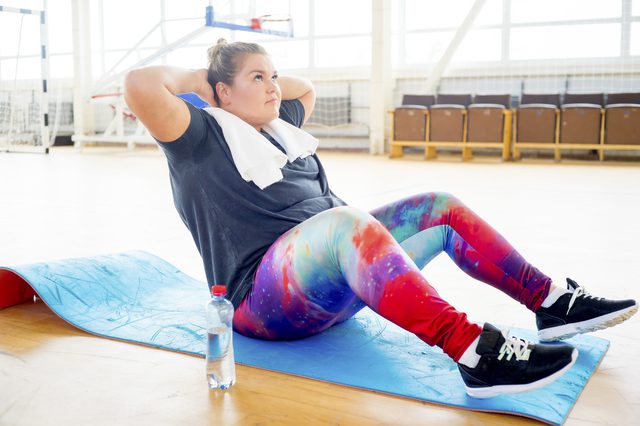10 signs that your training is ineffective
Advertisements
There are many similarities between romance and exercise. At first, you are eager to go to the gym and work hard. You feel good, you sleep better, and you're generally happy. It's honeymoon, and it will change one day. You lose motivation. You're no longer motivated. Everything hurts. To be honest, you just want to end it. You and your exercise obviously need to "talk," but it's a thin line between sticking to it and knowing when to throw in the towel. Here are 10 signals to help you decide if you should give up your exercise plan and find a new one!
integral: hero image / hero image / gettyimages " from breaking an action in a dance based fitness course to going forward in a kayak on the open water, there is infinite possibility of a great exercise. " Or try a new gym, says Neil Pires, a New Jersey sportsman. Conditioning experts. " "Do the same exercise elsewhere," Pillay said. New machines and environments, and maybe different music, will inspire you. " points: 10000 hours / digital vision / gettyimages Advertisements when you're always hurt or hurt, it's time to step back. " "Overtraining is likely to cause muscle soreness and tenderness," Matthews said. Overtraining, as the name suggests, is a continuous high-intensity training without enough time to recover. " Over training will not only have a negative impact on your physical health through sleep pattern disorder, loss of appetite and performance decline, but also cause damage to your emotional health. The latter is often called burnout, including irritability, depression and insomnia. Matthews recommends that recovery and rest days be scheduled in the same way that you schedule exercise days. integral: violetastoimenova / iStock / gettyimages Credit: elenanichizhenova / iStock / gettyimages " the key is to change the way you exercise before you feel depressed, "Pillay said. If you've been doing traditional weight training, you can switch to cycling or interval training, which provides a completely different thrill. "Cardio interval training can replace cardio and get you out of the gym faster. integral: primagefactory / iStock / gettyimages morning training is not for everyone. If you find yourself drinking a few cups of coffee and still feeling drowsy when you go to the gym, you need more sleep than exercise, Pillay said. Giving up sleep for exercise can create a dilemma because both are important aspects of a healthy lifestyle. A 2013 study by Northwestern University showed that a good night's sleep can lead to better and longer exercise time later in the day. The less time, the less motivated you are to exercise. The night before exercise in the morning is 20 to 30 minutes earlier than usual, or schedule activities into the day, rather than sacrificing morning sleep. integral: milkos / iStock / gettyimages when your exercise feels relaxed, it means you are improving. This is good news! But Rubinstein says it's time to add some changes when you're no longer challenged. " Since our poddie adapts to stress, it's best to change your training plan every 4 to 8 weeks to prevent (lack of challenge) adaptation. " " Rubinstein suggests that you" cycle "your training; create a structured training plan commonly used by professional athletes. It optimizes the adaptation process, so your body always has to improve, "Rubinstein said. Consider hiring a personal trainer to make a plan. Or you can interrupt your training. Focus for four weeks, then focus on endurance next month. Advertisements Credits: elenanichizhenova / iStock / gettyimages Credit: Jacobs stock photography Co., Ltd. / digital vision / gettyimages you are working hard. So why does the balance move in the wrong direction? You may eat more to compensate for hypoglycemia caused by strenuous aerobic exercise or strength training, or you may reward yourself for doing a good job by resting more than a day, Rubinstein said. People who start exercise or diet programs often erode their positive outcomes by engaging in self indulgent behavior. Solution: pay attention to calorie intake, exercise all day, keep metabolism active. integral: Vera arc / eyeem / eyeem / gettyimages according to the guidelines of the National Association of forces and conditioning, if you want to exercise strength, focus on a weight that you can lift six times or less; if you want to grow muscle (hypertrophy), use less weight and pump it out between six and 12 repetitions. For muscle endurance, further weight loss until you find a weight that you can lift more than 12 to 15 times. For more specific plans, consult a qualified personal trainer or strength coach. points: hero picture / hero picture / gettyimages Advertisements 1. You'd rather go to the dentist than go to the gym, but when you think about going to the gym recently, you want to put the quilt on your head. What's the matter? " If you find yourself afraid of exercise, it's time to try some new ways to sweat, "said assistant professor Jessica Matthews, director and founder of the master's degree in exercise physiology in the comprehensive health program at the University of portsmonazarez. "
2. You're always hurt or hurt.

3. At the beginning, you felt like every exercise had a result, but now you feel like you didn't make any progress a few months ago. What are the benefits? " However, IRV Rubenstein, a sports physiologist and founder of S.T.E.P.S., a scientific fitness organization in Nashville, Tennessee, said: "when we train, our muscles, heart, even brain and nervous system will adapt to the pressure we put on them, and the level training you just started will no longer stimulate these systems to adapt." After this stage of neuroadaptation, you will find it difficult to see the results. Add time (duration), frequency (number of times per week), intensity (weight or resistance) or more, although not all at once, to get things back on track.
4. You are always tired. Regular exercise should give you energy, not make you tired. " Constant fatigue is a typical sign of overtraining, which means you don't get enough recovery. The best thing you can do is to schedule a few days off, a week at most, and start a new training program on a specific day. " This revised training does not require all new training. Reframe your usual plan. Pires recommends changing the way you exercise (planned exercise), load (intensity or weight lifting), repeat and / or set the range (volume) and speed or rhythm of your weight lifting exercise. The contribution of
5. You'd rather do aerobics than walk on a treadmill or ride a stationary bike. Planning and doing resistance training requires more thought and energy. If you don't put in enough exercise, it's easy to lose weight and do an hour of aerobic exercise. "
6. You can't gather for morning training

7. Your exercise feels relaxed

8. If you are like most people, you can only do the best action, your favorite sport is probably your strongest sport. Doing your best exercise will improve your self-esteem, but if you never get out of your favorite actions, you can reach a plateau of stagnant results. A comprehensive exercise doesn't just include your favorite, Pillay saysYou also want to work out muscle groups on a consistent basis, but it's better to do a major "mother" type of weight lifting, and then add other exercises around it that can work out the same muscles. You're still training the same muscle groups, just different. " For example, if you like squats, you can add one leg of squats or squats. If you like chest compressions best, add some cable flies or reduce compressions to change the situation.
9. Your weight is increasing (when your goal is not to increase)

10. If you start exercising to lose weight and reach your goal (yeah! "It's time to change your goals," Pillay said. If you start to lose weight, it's time to change your posture and exercise your muscles. Your exercise needs to respond to your new goals. "











